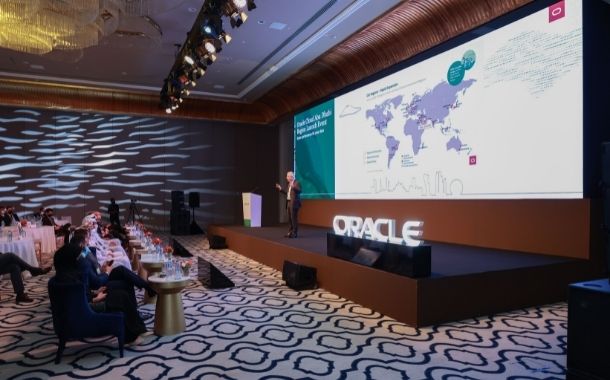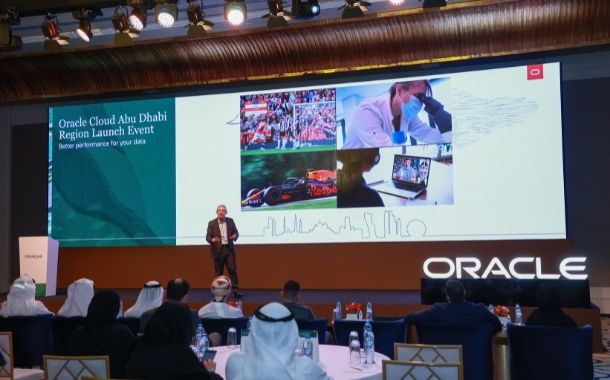Today, Oracle has 37 Cloud regions available and 7 more planned by the end of 2022. Inside UAE, two Cloud regions, Abu Dhabi and Dubai, are now live.
Within these cloud regions, Oracle offers more than 80 cloud infrastructure and platform services. Most cloud regions also offer Oracle Cloud Application SaaS portfolio. With public and hybrid cloud options, Oracle is now supporting local access, regional compliance, and business continuity.
The roll out of global cloud regions is in proximity to customers who need to meet their data sovereignty requirements. Another consideration is providing true disaster protection with multiple geographically distributed cloud datacentres for every cloud region and at least two cloud regions per country.
By launching the Abu Dhabi and Dubai Cloud regions inside UAE, Oracle has made these Cloud regions an extension of the datacentre of many enterprises inside the country, says Regis Louis, Vice President Cloud Strategy, EMEA Oracle.

“These Cloud regions give full resilience inside the country and all cloud services can be accessed inside the country,” adds Louis.
He cites the example of UAE based Landmark Group. “They moved 80% of their business to Oracle Cloud Infrastructure in 12 months.”
Inside these regions, Oracle has a unique hybrid cloud option, Dedicated Region Cloud@Customer, which offers Oracle Cloud services on the customer’s premises. This range of options provides customers access to all cloud services, with the same SLAs for availability, performance, and management, as well as consistent APIs for simplified management.
Louis tells UAE based businesses, “Cloud@Customer brings the cloud to you, and the full Oracle Cloud Infrastructure to your datacentre.”
For the Cloud regions inside UAE, Oracle provides SLAs on availability, performance, manageability, points out Louis. A high level of performance assured by these SLAs, implies that a faster business throughput is possible at a lesser cost.

Another plus point for businesses inside UAE adopting Oracle Cloud is that security is in-built inside every service and every application, hosted on Oracle Cloud Infrastructure. “It is always on and not provided as an option. It is fully automated and data is always encrypted,” says Louis.
The Saudi Arabian Mining Company moved its on-premises E-business suite to Oracle Cloud Infrastructure and received a 36% savings in their direct cost, cites Louis, as an example of the savings that can be generated by working within Oracle’s Cloud regions.
Oracle is also actively using AI and ML to manage the functioning of its Autonomous Database Manager. Oracle data management offers freedom from silos of information, making it easier to access and extract value from data. Automation of security, patching, and configuration with Oracle Autonomous Database eliminates time-consuming administrative tasks and human error. With these tools, “there is no human error,” says Louis.
Oracle Cloud Infrastructure’s physical and virtual network design maximises performance and security and enables the fast provisioning and on-demand consumption of more than 80 cloud services, including unique bare metal GPUs, clustered databases, and Oracle Exadata database-optimised shapes.
Each Oracle Cloud region contains at least three fault domains, which are groupings of hardware that form logical datacentres for high availability and resilience to hardware and network failures.

Oracle Cloud Infrastructure’s, cloud services are open, and embrace standards like Kubernetes, CloudEvents, and Terraform so that customers can enjoy portability, lower overhead, and lower costs. Oracle Autonomous Database is available for both existing and new applications, which is optimised for transaction processing, data warehousing, or JSON, with automatic tuning, scaling, and patching.
By having visibility and control over the hardware at the end of its useful life in Oracle Cloud, Oracle is also able to repurpose equipment more effectively, harvest spare parts, and maximise the recycling of materials.
Within these Oracle Cloud regions, customers can run applications they migrate, applications they build, and a broad range of horizontal and industry SaaS, all out of the same cloud. Oracle Cloud Regions can not only run customer workloads, but also offer enterprise SaaS like Oracle Fusion Cloud ERP, Oracle Human Capital Management, and Oracle Supply Chain Planning.

For the demands of multicloud, Oracle Cloud Infrastructure and Microsoft Azure have a strategic partnership that enables joint customers to run workloads across the two clouds.
This partnership provides a low latency cross-cloud interconnect between Oracle Cloud Infrastructure and Azure in six regions, federated identity for joint customers to deploy applications across both clouds, and a collaborative support model. Customers can run full stack applications in a multi-cloud configuration, while maintaining high performance connectivity without requiring re-architecture.
How the UAE gains
Data compliance
Data stays inside UAE, supporting local data regulations and data sovereignty.
High availability
Companies benefit from architecture designed to maximize performance, and data security.
Cloud services for every workload
UAE gets 85+ OCI services on a high-bandwidth backbone.
Easier cloud migration
Businesses will enjoy a simpler cloud migration for all their IT workloads.
Reduced costs and enhanced performance
Businesses can take advantage of low-latency predictable costs.
Improved customer experiences
Businesses get connectivity between cloud regions with Oracle FastConnect for use cases like data transfer or end-user access to cloud applications.
Superior resiliency
Organizations get better disaster protection and additional security with two cloud regions inside UAE.
Reduce environmental impacts through sustainability
Leverage state-of-the-art intelligent energy management.
Characteristics of Oracle Cloud Infrastructure datacentres
Oracle has a goal of achieving 100% renewable energy use in all its Oracle Cloud Infrastructure datacentres by 2025.
Resiliency and high availability
Oracle Cloud datacentres align with Uptime Institute and Telecommunications Industry Association ANSI, TIA-942-A Tier 3 or Tier 4 standards and follow a N2 redundancy methodology for critical equipment operation. Datacentres use redundant power sources and maintain generator backups in case of widespread electrical outage.
Physical security
Oracle Cloud datacentres incorporate physical access, alarms, CCTV monitoring, 24X7 onsite guards.
Environmental monitoring
Temperature and humidity are controlled to align to industry standards, enabling optimal performance. Server rooms are equipped with feature fire-suppression systems to protect Oracle’s equipment.
Site locations
Datacentre sites undergo a risk evaluation that considers environmental threats, power availability and stability, vendor reputation and history, neighbouring facility functions including high-risk manufacturing and high-threat targets, and geopolitical considerations, among other criteria.
Compliance
Oracle Cloud Regions are regularly assessed as part of Oracle Cloud Infrastructure’s compliance programs.
85+ Oracle Cloud services available within Oracle Cloud regions
- Oracle Application Performance Monitoring
- Oracle Autonomous Transaction Processing
- Oracle Autonomous Data Warehouse
- Oracle Autonomous JSON Database
- Oracle APEX Application Development
- Oracle Cloud Infrastructure Compute VM
- Oracle Cloud Infrastructure Block Volumes
- Oracle Cloud Infrastructure Object Storage
- Oracle Cloud Infrastructure Archive Storage
- Oracle Cloud Infrastructure Load Balancing
- Oracle Cloud Infrastructure Monitoring
- Oracle Cloud Infrastructure Notifications
- Oracle Application Performance Monitoring
- Oracle Cloud Infrastructure Anomaly Detection
- Oracle Cloud Infrastructure Artifact Registry
- Oracle Autonomous Transaction Processing
- Oracle Autonomous Data Warehouse
- Oracle Autonomous JSON Database
- Oracle APEX Application Development
- Oracle Data Safe
- Oracle Functions
- Oracle Cloud Guard
- Oracle Cloud Infrastructure API Gateway
- Oracle Cloud Infrastructure Archive Storage
- Oracle Cloud Infrastructure Audit
- Oracle Cloud Infrastructure Bastion
- Oracle Cloud Infrastructure Block Volumes
- Oracle Cloud Infrastructure Compliance Documents
- Oracle Cloud Infrastructure Compute
- Oracle Cloud Infrastructure Compute GPU
- Oracle Cloud Infrastructure Compute HPC
- Oracle Cloud Infrastructure Container Engine for Kubernetes
- Oracle Cloud VMware Solution
- Oracle Cloud Infrastructure Database Cloud Service
- Oracle Cloud Infrastructure Database Management
- Oracle Cloud Infrastructure Database Migration
- Oracle Cloud Infrastructure Data Catalog
- Oracle Cloud Infrastructure Data Flow
- Oracle Cloud Infrastructure Data Integration
- Oracle Cloud Infrastructure Data Labeling
- Oracle Cloud Infrastructure Data Science
- Oracle Cloud Infrastructure Data Transfer Service
- Oracle Cloud Infrastructure DevOps
- Oracle Cloud Infrastructure DNS
- Oracle Cloud Infrastructure Email Delivery
- Oracle Cloud Infrastructure Events
- Oracle Cloud Infrastructure Exadata Cloud Service
- Oracle Cloud Infrastructure FastConnect
- Oracle Cloud Infrastructure File Storage
- Oracle Cloud Infrastructure GoldenGate
- Oracle Cloud Infrastructure Identity and Access Management
- Oracle Cloud Infrastructure Language
- Oracle Cloud Infrastructure Load Balancing
- Oracle Cloud Infrastructure Logging
- Oracle Cloud Infrastructure Logging Analytics
- Oracle Cloud Infrastructure Monitoring
- Oracle Cloud Infrastructure Notifications
- Oracle Cloud Infrastructure Object Storage
- Oracle Cloud Infrastructure Operations Insights
- Oracle Cloud Infrastructure Registry
- Oracle Cloud Infrastructure Resource Manager
- Oracle Cloud Infrastructure Storage Gateway
- Oracle Cloud Infrastructure Streaming
- Oracle Cloud Infrastructure Tagging
- Oracle Cloud Infrastructure Traffic Management
- Oracle Cloud Infrastructure Vulnerability Scanning Service
- Oracle Cloud Infrastructure to Microsoft Azure Interconnect
- Oracle Cloud Infrastructure Vault
- Oracle Cloud Infrastructure Virtual Cloud Network
- Oracle Analytics Cloud
- Oracle Big Data Service
- Oracle Blockchain Platform
- Oracle Content and Experience
- Oracle Visual Builder Studio
- Oracle Digital Assistant
- Oracle Exadata Cloud at Customer
- Oracle Health Checks
- Oracle Identity Cloud
- Oracle Integration
- Oracle Java Cloud Service
- Oracle Management Agent Cloud Service
- Oracle MySQL Database Service
- Oracle NoSQL Database Cloud Service
- Oracle Security Zones
- Oracle Visual Builder
- Java Management Service
Audit framework of Oracle Cloud regions
They have been assessed by independent assessors to meet the requirements of the Security, Breach Notification, and Privacy Rules of the Health Insurance Portability and Accountability Act of 1996, as amended, in accordance with the Standards set forth in HIPAA Administrative Simplification Regulation Text 45 CFR Part 164 Subpart—Security Standards for the Protection of electronic Protected Health Information, Subpart—Notification in the Case of Breach of Unsecured Protected Health Information, and Subpart—Privacy of Individually Identifiable Health Information, as amended. Audit checks for Oracle Cloud datacentres can be as high as 800.

























